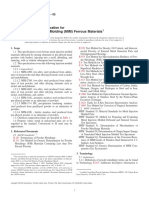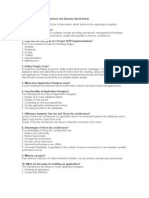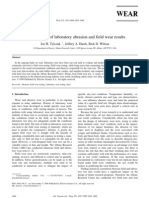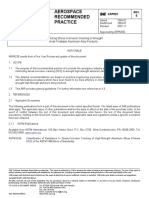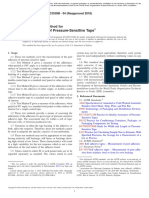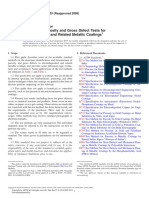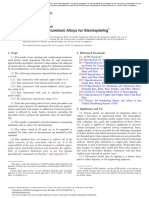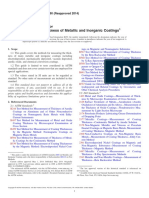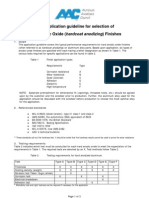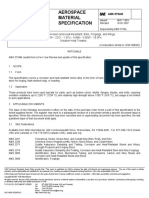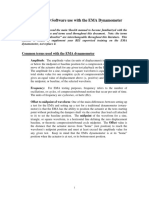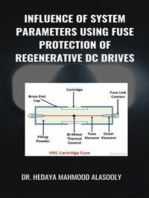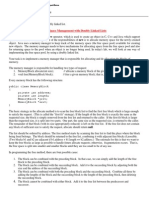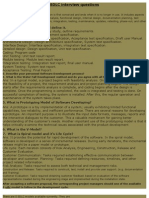100%(1)100% found this document useful (1 vote)
113 viewsWhy Intensity Isn't Dependent On Exposure Time: Lessons in Intensity and Coverage
Why Intensity Isn't Dependent On Exposure Time: Lessons in Intensity and Coverage
Uploaded by
Umit AytarThe document discusses the concepts of intensity and coverage in shot peening. It addresses a technician's question about whether intensity would be too high at the location with the shortest saturation curve exposure time if the machine cycle time was set for the longest exposure time.
The summary is:
1) Intensity remains constant throughout the peening process and does not depend on exposure time, unlike coverage which is exposure time dependent.
2) The technician had already calibrated the machine intensity to be within tolerance for each of the six locations tested.
3) According to a revised specification, confirmation tests can use a target time and target intensities rather than requiring tests at each location's individual exposure time. This allows setting
Copyright:
© All Rights Reserved
Available Formats
Download as PDF, TXT or read online from Scribd
Why Intensity Isn't Dependent On Exposure Time: Lessons in Intensity and Coverage
Why Intensity Isn't Dependent On Exposure Time: Lessons in Intensity and Coverage
Uploaded by
Umit Aytar100%(1)100% found this document useful (1 vote)
113 views1 pageThe document discusses the concepts of intensity and coverage in shot peening. It addresses a technician's question about whether intensity would be too high at the location with the shortest saturation curve exposure time if the machine cycle time was set for the longest exposure time.
The summary is:
1) Intensity remains constant throughout the peening process and does not depend on exposure time, unlike coverage which is exposure time dependent.
2) The technician had already calibrated the machine intensity to be within tolerance for each of the six locations tested.
3) According to a revised specification, confirmation tests can use a target time and target intensities rather than requiring tests at each location's individual exposure time. This allows setting
Original Description:
Shot Peening
Original Title
Shot Peening
Copyright
© © All Rights Reserved
Available Formats
PDF, TXT or read online from Scribd
Share this document
Did you find this document useful?
Is this content inappropriate?
The document discusses the concepts of intensity and coverage in shot peening. It addresses a technician's question about whether intensity would be too high at the location with the shortest saturation curve exposure time if the machine cycle time was set for the longest exposure time.
The summary is:
1) Intensity remains constant throughout the peening process and does not depend on exposure time, unlike coverage which is exposure time dependent.
2) The technician had already calibrated the machine intensity to be within tolerance for each of the six locations tested.
3) According to a revised specification, confirmation tests can use a target time and target intensities rather than requiring tests at each location's individual exposure time. This allows setting
Copyright:
© All Rights Reserved
Available Formats
Download as PDF, TXT or read online from Scribd
Download as pdf or txt
100%(1)100% found this document useful (1 vote)
113 views1 pageWhy Intensity Isn't Dependent On Exposure Time: Lessons in Intensity and Coverage
Why Intensity Isn't Dependent On Exposure Time: Lessons in Intensity and Coverage
Uploaded by
Umit AytarThe document discusses the concepts of intensity and coverage in shot peening. It addresses a technician's question about whether intensity would be too high at the location with the shortest saturation curve exposure time if the machine cycle time was set for the longest exposure time.
The summary is:
1) Intensity remains constant throughout the peening process and does not depend on exposure time, unlike coverage which is exposure time dependent.
2) The technician had already calibrated the machine intensity to be within tolerance for each of the six locations tested.
3) According to a revised specification, confirmation tests can use a target time and target intensities rather than requiring tests at each location's individual exposure time. This allows setting
Copyright:
© All Rights Reserved
Available Formats
Download as PDF, TXT or read online from Scribd
Download as pdf or txt
You are on page 1of 1
lessons in intensity and coverage
by Jack Champaigne | President | Electronics Inc. | jack.champaigne@electronics-inc.com
Why Intensity Isn’t
Dependent on Exposure Time
I recently received an e-mail from someone and in production, machine operators are required to make
thanking us for Dr. Kirk’s Curve Solver program, followed periodic intensity confirmation tests. These don’t have to be
by several interesting questions. The shot peening technician full saturation curves. Run a single strip through the machine
(let’s call him SPT) had a fixture with six Almen holders. He using the saturation curve exposure time of T1 and take that
understood how to run the fixture through their machine arc height as a confirmation of peening intensity. However, in
at four different exposure times, allowing him to construct our example, SPT has six locations to check and each location
a saturation curve according to SAE J443. (J443 requires a will have its own “T1” time. He needs to decide what time to
minimum of four data points on each curve.) He then had run the fixture through the machine for the future intensity
six curves, each with intensity value, but at differing T1 times. confirmation checks. J443 now allows using a “target” time
All of the intensity values were within the tolerance band with “target” intensities. Let me explain.
allowed. SPT wanted to know “if his machine cycle time was Visualize a graph with six saturation curves on it. These
set for the longest T1 time, would the intensity be too high for curves represent the Almen strip arc heights for six different
the shortest T1 time?” locations on the fixture. Using Dr. Kirk’s Curve Solver, you
The short answer is NO. SPT needs to understand why intensity can find the intensity for each graph and its corresponding
isn’t related to exposure time and that he needs to conduct T1 time. Earlier specifications required that you run the
two independent tasks—one to determine intensity and one confirmation tests at the T1 time. What happens if you have
to determine coverage, which is exposure time dependent. He six locations and six T1 times? Were you expected to run six
had already calibrated the machine to a requested intensity. different confirmation passes, one for each T1 time? Most
Each Almen holder position was receiving impacts within the people didn’t follow that rule.
requested intensity. The intensity values were not exactly the Thanks to J443 you are now allowed to pick any time you wish,
same but they were all within the tolerance band required. which is within the shortest and longest T1 time for the six
His next task would be to determine exposure time and curves. Pick a time, draw a vertical line on the graph and see
this would be done by incrementally blasting his target for where the line intersects each of the six curves. These points
brief times and inspecting for coverage (surface denting). are now your “target” arc heights, one for each location. So
When the entire part is completely dented, he then has 100% if you run your fixture through the machine, you will get six
coverage and now the machine cycle time can be established. arc heights. If you do this once each day you should get the
What about his concern that the intensity at the location of same “target” arc height for each location. Each confirmation
his shortest T1 time might be “out of spec” or “too high”? arc height must be within ±0.038 mm or ±0.0015 inch of its
The intensity at that location was already proven to be within corresponding target arc height. If any of the confirmation
the tolerance band. Every shot particle is being impacted at arc heights is not within this tolerance band, you must make
that intensity. The intensity does not change with time. The adjustments (perhaps machine maintenance) and then
intensity will change if he changes operating parameters like perform a new set of six saturation curves. l
air pressure, nozzle style, shot hardness, etc., but it does not
change with time.
If intensity changed with time, then peening a large part,
Free Download
perhaps needing two hours for complete coverage, would Dr. Kirk’s Almen Saturation Curve Solver Program
suffer from a very high intensity at the end of the cycle.
The Almen Saturation Curve Solver Program will
Intensity stays fixed throughout the cycle unless you change
automatically determine the Almen intensity and draw
an operating parameter.
a graph. The program uses a MicroSoft Excel spreadsheet
Since we are talking about intensity checks in six locations, it with the “Solver” add-in. The program is easy to use:
might be useful to remember that SAE J443 has been updated Input data (time and arc heights) and then click
to accommodate multi-holder situations. Remember, a new on “tools” and “solver” to get an answer.
setup requires a saturation curve using a minimum of four
data points for each holder. Once the machine is accepted Download at www.shotpeener.com
40 The Shot Peener | Winter 2014
You might also like
- Install Unbound DNSDocument7 pagesInstall Unbound DNSvelufun0% (1)
- Btec National Information TechnologyDocument24 pagesBtec National Information TechnologyRini SandeepNo ratings yet
- ASTM B883Standard Specification For Metal Injection Molding (MIM) Ferrous Materials1Document5 pagesASTM B883Standard Specification For Metal Injection Molding (MIM) Ferrous Materials1David VegaNo ratings yet
- Peoplesoft Interview QuestionsDocument31 pagesPeoplesoft Interview Questionsandysusilook@yahoo.comNo ratings yet
- Atlas of Stress-Strain Curves: Second EditionDocument5 pagesAtlas of Stress-Strain Curves: Second EditionLucio MárquezNo ratings yet
- Iso 14577 1 2002 FR en PDFDocument11 pagesIso 14577 1 2002 FR en PDFPaulo Jorge100% (1)
- A Comparison of Laboratory Abrasion and Field Wear ResultsDocument11 pagesA Comparison of Laboratory Abrasion and Field Wear ResultschrisnnnNo ratings yet
- Brochure - Rev 15 PDFDocument9 pagesBrochure - Rev 15 PDFCicero Gomes de SouzaNo ratings yet
- Shot Peening Coverage Requirements: Academic StudyDocument6 pagesShot Peening Coverage Requirements: Academic StudyUmit AytarNo ratings yet
- Principles of Almen Strip Selection: Academic StudyDocument5 pagesPrinciples of Almen Strip Selection: Academic StudyUmit AytarNo ratings yet
- Micrometer Bend Test For Ductility of ElectrodepositsDocument2 pagesMicrometer Bend Test For Ductility of ElectrodepositsJohnny100% (1)
- Matsci 10 11Document35 pagesMatsci 10 11go427794100% (1)
- Sae Arp823e-2007Document4 pagesSae Arp823e-2007aleeimeran100% (1)
- Technical Bulletin - Acid EtchDocument4 pagesTechnical Bulletin - Acid EtchOla Olatunji100% (1)
- Heat Treatment Non FerrousDocument4 pagesHeat Treatment Non FerrousJhalbert BelmonteNo ratings yet
- Machining of AlDocument44 pagesMachining of AlMuhammad Waleed Anjum100% (1)
- Ansi 105 en 388 What You Need To KnowDocument1 pageAnsi 105 en 388 What You Need To KnowGiordano BorjaNo ratings yet
- Catalogue Cen TC 132 August 2016Document32 pagesCatalogue Cen TC 132 August 2016Mario Barbarić100% (1)
- Iso 6361 4 2011Document9 pagesIso 6361 4 2011Abhilash BaranwalNo ratings yet
- Military Specification MIL-A-8625 Anodic Coatings - AACDocument2 pagesMilitary Specification MIL-A-8625 Anodic Coatings - AACZASSNo ratings yet
- QQ N 290aDocument17 pagesQQ N 290aBryan MartinezNo ratings yet
- Mil C 26074eDocument11 pagesMil C 26074edharlanuctcomNo ratings yet
- Nitriding Nitrocarburizing Complying To Automotive Aerospace SpecsDocument45 pagesNitriding Nitrocarburizing Complying To Automotive Aerospace SpecsCristofer CrisNo ratings yet
- Standard Test Method For Peel Adhesion of Pressure-Sensitive TapeDocument6 pagesStandard Test Method For Peel Adhesion of Pressure-Sensitive Tapeגבריאל קלין100% (1)
- Special Process Presentation NewDocument23 pagesSpecial Process Presentation Newvivek nuthiNo ratings yet
- Specifying Anodized Aluminum AACDocument19 pagesSpecifying Anodized Aluminum AACkaka**100% (1)
- Mil PRF 8625 Amend02Document20 pagesMil PRF 8625 Amend02dan hows100% (1)
- Nitriding 4340 ADocument8 pagesNitriding 4340 AyanuarNo ratings yet
- AMS AM P18183097 Brochure FinalDocument7 pagesAMS AM P18183097 Brochure FinalRaj RajeshNo ratings yet
- Rheocasting of Semi-Solid A357 AluminumDocument7 pagesRheocasting of Semi-Solid A357 AluminumikehrpNo ratings yet
- Reporting Uniaxial Strength Data and Estimating Weibull Distribution Parameters For Advanced CeramicsDocument17 pagesReporting Uniaxial Strength Data and Estimating Weibull Distribution Parameters For Advanced CeramicsMehdi GouaderNo ratings yet
- Mil I 17563CDocument18 pagesMil I 17563Cchitti409No ratings yet
- Astm B765Document4 pagesAstm B765Purushottam Sutar100% (2)
- Porous Anodic Aluminum Oxide: Anodization and Templated Synthesis of Functional NanostructuresDocument70 pagesPorous Anodic Aluminum Oxide: Anodization and Templated Synthesis of Functional NanostructuresVũ Hoàng QuânNo ratings yet
- Sae As14101bDocument3 pagesSae As14101bTom ZhangNo ratings yet
- Mil S 13165Document20 pagesMil S 13165Hòa NguyễnNo ratings yet
- GMW 14057Document10 pagesGMW 14057JOECOOL67No ratings yet
- ISO-6361-2-2014 Wrought Aluminium and Aluminium Alloys - Sheets, Strips & Plate - Insulation CladdingDocument15 pagesISO-6361-2-2014 Wrought Aluminium and Aluminium Alloys - Sheets, Strips & Plate - Insulation CladdingYogalingam Arumugam100% (1)
- B253.25617 Prepar AlumDocument7 pagesB253.25617 Prepar Alumasistente calidadNo ratings yet
- B 438 - B 438m - 00 Qjqzoc9cndm4ts1sruqDocument12 pagesB 438 - B 438m - 00 Qjqzoc9cndm4ts1sruqPablo Andrés Pino MeriñoNo ratings yet
- Aerospace CustomersDocument3 pagesAerospace CustomersSinan YıldızNo ratings yet
- Determining The Susceptibility To Intergranular Corrosion of 5XXX Series Aluminum Alloys by Mass Loss After Exposure To Nitric Acid (NAMLT Test)Document3 pagesDetermining The Susceptibility To Intergranular Corrosion of 5XXX Series Aluminum Alloys by Mass Loss After Exposure To Nitric Acid (NAMLT Test)benjaminverduzco4No ratings yet
- ASTM-D2803 Standard Guide For Testing Filiform Corrosion Resistance of Organic Coatings On Metal PDFDocument3 pagesASTM-D2803 Standard Guide For Testing Filiform Corrosion Resistance of Organic Coatings On Metal PDFCemalOlgunÇağlayanNo ratings yet
- 1984 Surf Roughness PGDocument8 pages1984 Surf Roughness PGHussn Yazdan100% (1)
- ASTM B659 90 Reapproved 2014 PDFDocument3 pagesASTM B659 90 Reapproved 2014 PDFFrancisco PerezNo ratings yet
- ASTM+B777-2015 WAlloyDocument3 pagesASTM+B777-2015 WAlloyjoeuneloveNo ratings yet
- Qnix 8500 Data SheetDocument10 pagesQnix 8500 Data SheetMustafa BahtiyarNo ratings yet
- AAC2010 Guideline For Hard Anodic Oxide CoatDocument3 pagesAAC2010 Guideline For Hard Anodic Oxide CoatPalaNo ratings yet
- The History of Shot Peening Peenable Materials Shot MediaDocument1 pageThe History of Shot Peening Peenable Materials Shot MediaJason VolneyNo ratings yet
- Aerospace Material SpecificationDocument6 pagesAerospace Material SpecificationAnonymous T6GllLl0No ratings yet
- Eye ProtectionDocument4 pagesEye ProtectionverlinaintanNo ratings yet
- Aluminum and Aluminum-Alloy Sheet and Plate (Metric) : Standard Specification ForDocument26 pagesAluminum and Aluminum-Alloy Sheet and Plate (Metric) : Standard Specification ForPUENTES2407No ratings yet
- Iso 4519 1999Document9 pagesIso 4519 1999djmattmNo ratings yet
- M0140 (2014-N) NES: Salt Spray TestingDocument11 pagesM0140 (2014-N) NES: Salt Spray TestingBea RiveraNo ratings yet
- Iso 4628 4 2003Document9 pagesIso 4628 4 2003AgungNo ratings yet
- ASTM A563 - Portland BoltDocument5 pagesASTM A563 - Portland BoltamrNo ratings yet
- Qualanod Spec. Ed 01.01.19Document78 pagesQualanod Spec. Ed 01.01.19Abdul Rahman ObaidNo ratings yet
- ASTM-B487-20 RedlineDocument4 pagesASTM-B487-20 Redlinemarcio de rossi100% (1)
- How To Use Anodizing Defects Catalogue Photo Gallery: 3.1 Acid CorrosionDocument21 pagesHow To Use Anodizing Defects Catalogue Photo Gallery: 3.1 Acid CorrosionSatyendra PandeyNo ratings yet
- Shock6 Manual EMADocument26 pagesShock6 Manual EMAFausto TrentiniNo ratings yet
- Fatigue 1Document3 pagesFatigue 1Mahesh KhadeNo ratings yet
- DFT Interview Questions and Answers: 1. Re: Handling Reset During Transition Fault Pattern GenerationDocument10 pagesDFT Interview Questions and Answers: 1. Re: Handling Reset During Transition Fault Pattern GenerationShankhadeep DasNo ratings yet
- Influence of System Parameters Using Fuse Protection of Regenerative DC DrivesFrom EverandInfluence of System Parameters Using Fuse Protection of Regenerative DC DrivesNo ratings yet
- Patran 2010 Training 301 Coursenotes PDFDocument865 pagesPatran 2010 Training 301 Coursenotes PDFUmit AytarNo ratings yet
- QQI Shim Magnaflux PDFDocument2 pagesQQI Shim Magnaflux PDFUmit AytarNo ratings yet
- An Overview of Shot - Peening: A Niku-Lari IITT, FranceDocument25 pagesAn Overview of Shot - Peening: A Niku-Lari IITT, FranceUmit AytarNo ratings yet
- QQI Shim Magnaflux PDFDocument2 pagesQQI Shim Magnaflux PDFUmit AytarNo ratings yet
- Saturation PointDocument6 pagesSaturation PointUmit AytarNo ratings yet
- OP1111Document5 pagesOP1111Umit AytarNo ratings yet
- JEDI - Introduction - To.java - Programming.vol.2Document187 pagesJEDI - Introduction - To.java - Programming.vol.2Johanna Mariz100% (2)
- Write A Java Class To Store Following Information:: Name Roll Number Cgpa SemesterDocument13 pagesWrite A Java Class To Store Following Information:: Name Roll Number Cgpa SemesterVaibhavGuptaNo ratings yet
- Dis11 SolDocument5 pagesDis11 SolMichael ARKNo ratings yet
- CMT CSDocument2 pagesCMT CSEngr Mohammad Mamunul IslamNo ratings yet
- 006 - BCS-042 D18 - Compressed PDFDocument4 pages006 - BCS-042 D18 - Compressed PDFPawan SahuNo ratings yet
- CBNST Lab FileDocument20 pagesCBNST Lab FileMohit Singh0% (1)
- Numerical Methods Overview of The CourseDocument93 pagesNumerical Methods Overview of The CoursechetanNo ratings yet
- E-Learning Kemenkeu Corpu PDFDocument17 pagesE-Learning Kemenkeu Corpu PDFPusbangkom Teknis & Sosial Kultural ASN LANNo ratings yet
- An Modeler Preparing Autocad Files Jun2009 PDFDocument5 pagesAn Modeler Preparing Autocad Files Jun2009 PDFNATHANNo ratings yet
- Salient Features of The Information TechnologyDocument3 pagesSalient Features of The Information TechnologyVivek Singh100% (1)
- Virtual Medical ScribesDocument4 pagesVirtual Medical ScribesphysiciansangelsNo ratings yet
- SectionA GroupDocument3 pagesSectionA GroupKeerthiraj ManiNo ratings yet
- APACHE Web Server and SSL AuthenticationDocument8 pagesAPACHE Web Server and SSL AuthenticationDJ JAMNo ratings yet
- History of File StructuresDocument26 pagesHistory of File StructuresRuchitha BalakrishnaNo ratings yet
- Lab 09 - Doubly Linked ListDocument1 pageLab 09 - Doubly Linked Listadil054No ratings yet
- Tok EssayDocument3 pagesTok EssayAaryan ChhabraNo ratings yet
- Static Functions in Linux Device DriverDocument4 pagesStatic Functions in Linux Device DriverAkhilesh ChaudhryNo ratings yet
- Pytthon For Data Analysis From ScratchDocument37 pagesPytthon For Data Analysis From Scratchxwpom2100% (5)
- Parse Json in Java Example.Document3 pagesParse Json in Java Example.Jai PannuNo ratings yet
- Oracle SQL High Performance Tuning: Guy Harrison Director, R&D MelbourneDocument56 pagesOracle SQL High Performance Tuning: Guy Harrison Director, R&D MelbourneZakir ChowdhuryNo ratings yet
- SDLC QuestionsDocument2 pagesSDLC QuestionsGadadhar Tiwary100% (1)
- UserGuide Android INCENTER2.0 InspectionKit PDFDocument26 pagesUserGuide Android INCENTER2.0 InspectionKit PDFIsaacNo ratings yet
- Filip FlopsDocument4 pagesFilip FlopsMohammed JeelanNo ratings yet
- 2024 - KK - Curriculum Overview ParentDocument21 pages2024 - KK - Curriculum Overview Parentblab ouerNo ratings yet
- Openr2 Guide 0.1Document16 pagesOpenr2 Guide 0.1jlngaribaldiNo ratings yet
- Sportograf 2024 - Photography For The Love of SportDocument8 pagesSportograf 2024 - Photography For The Love of Sportn.aravind80No ratings yet
- csc3112 Lecture6Document23 pagescsc3112 Lecture6Nerys100% (1)


